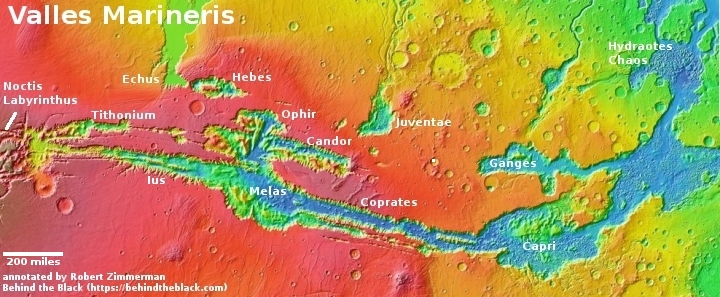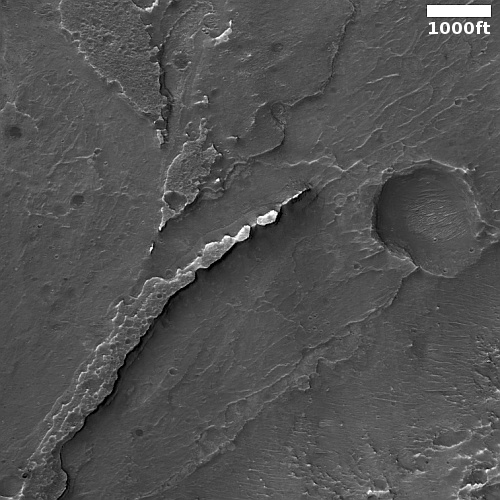Razor butte on Mars
Cool image time! The picture to the right, cropped, reduced, and sharpened to post here, was taken on November 18, 2022 by the high resolution camera on Mars Reconnaissance Orbiter (MRO). The science team labeled this image “Inverted Channel and Possible Lake Deposits.” The sharp razor-like butte, which I estimate is about 200 to 400 feet high, is an example of the several inverted channels in the full image. The serrated-edged flat plateau at the top of this picture, one of several in the full image, is an example of those possible lake deposits.
Why do the scientists think a lake might have once been here? Located at 8 degrees north latitude in the dry equatorial regions of Mars, there is almost certainly no near surface ice here now.
As always, the overview map provides the context, and a possible explanation.

The dot west of Ganges canyon marks the location of this picture, which covers the northwest quadrant of a 30-mile-wide unnamed crater on the plateau north of the giant canyon Valles Marineris.
Scientists have accumulated a lot of evidence that the canyons and craters north of Valles Marineris once held lakes. For example, see this November 2020 post about a paper outlining the evidence that lakes and rivers once existed to the west of the sixty-mile-wide and three-mile deep Juventae Chasma, about 150 miles to the northwest of this crater. At that location MRO images found inverted channels similar to the razor butte above. As I wrote then,
What scientists think happened is that in the past an intermittent lake of varying depth … would come and go … at intervals separated by 100 to 100,000 years, with the lakes themselves possibly lasting as long at 10,000 years.
As the lakes ebbed and flowed, they eroded the bedrock on the floor of the crater. The ridges represent former flow channels. Because the channel floor was packed down by the flow, it became denser, and thus remained behind as the surrounding terrain was eroded away.
On Christmas Eve 1968 three Americans became the first humans to visit another world. What they did to celebrate was unexpected and profound, and will be remembered throughout all human history. Genesis: the Story of Apollo 8, Robert Zimmerman's classic history of humanity's first journey to another world, tells that story, and it is now available as both an ebook and an audiobook, both with a foreword by Valerie Anders and a new introduction by Robert Zimmerman.
The print edition can be purchased at Amazon or from any other book seller. If you want an autographed copy the price is $60 for the hardback and $45 for the paperback, plus $8 shipping for each. Go here for purchasing details. The ebook is available everywhere for $5.99 (before discount) at amazon, or direct from my ebook publisher, ebookit. If you buy it from ebookit you don't support the big tech companies and the author gets a bigger cut much sooner.
The audiobook is also available at all these vendors, and is also free with a 30-day trial membership to Audible.
"Not simply about one mission, [Genesis] is also the history of America's quest for the moon... Zimmerman has done a masterful job of tying disparate events together into a solid account of one of America's greatest human triumphs."--San Antonio Express-News
Cool image time! The picture to the right, cropped, reduced, and sharpened to post here, was taken on November 18, 2022 by the high resolution camera on Mars Reconnaissance Orbiter (MRO). The science team labeled this image “Inverted Channel and Possible Lake Deposits.” The sharp razor-like butte, which I estimate is about 200 to 400 feet high, is an example of the several inverted channels in the full image. The serrated-edged flat plateau at the top of this picture, one of several in the full image, is an example of those possible lake deposits.
Why do the scientists think a lake might have once been here? Located at 8 degrees north latitude in the dry equatorial regions of Mars, there is almost certainly no near surface ice here now.
As always, the overview map provides the context, and a possible explanation.

The dot west of Ganges canyon marks the location of this picture, which covers the northwest quadrant of a 30-mile-wide unnamed crater on the plateau north of the giant canyon Valles Marineris.
Scientists have accumulated a lot of evidence that the canyons and craters north of Valles Marineris once held lakes. For example, see this November 2020 post about a paper outlining the evidence that lakes and rivers once existed to the west of the sixty-mile-wide and three-mile deep Juventae Chasma, about 150 miles to the northwest of this crater. At that location MRO images found inverted channels similar to the razor butte above. As I wrote then,
What scientists think happened is that in the past an intermittent lake of varying depth … would come and go … at intervals separated by 100 to 100,000 years, with the lakes themselves possibly lasting as long at 10,000 years.
As the lakes ebbed and flowed, they eroded the bedrock on the floor of the crater. The ridges represent former flow channels. Because the channel floor was packed down by the flow, it became denser, and thus remained behind as the surrounding terrain was eroded away.
On Christmas Eve 1968 three Americans became the first humans to visit another world. What they did to celebrate was unexpected and profound, and will be remembered throughout all human history. Genesis: the Story of Apollo 8, Robert Zimmerman's classic history of humanity's first journey to another world, tells that story, and it is now available as both an ebook and an audiobook, both with a foreword by Valerie Anders and a new introduction by Robert Zimmerman.
The print edition can be purchased at Amazon or from any other book seller. If you want an autographed copy the price is $60 for the hardback and $45 for the paperback, plus $8 shipping for each. Go here for purchasing details. The ebook is available everywhere for $5.99 (before discount) at amazon, or direct from my ebook publisher, ebookit. If you buy it from ebookit you don't support the big tech companies and the author gets a bigger cut much sooner.
The audiobook is also available at all these vendors, and is also free with a 30-day trial membership to Audible.
"Not simply about one mission, [Genesis] is also the history of America's quest for the moon... Zimmerman has done a masterful job of tying disparate events together into a solid account of one of America's greatest human triumphs."--San Antonio Express-News



Instapundit pointed to this piece (from Icarus last year) a handful of days ago, revealing evidence that there’s presently lots of water down under the floor of parts of Valles Marineris’ canyon(s), to wit: “The evidence for unusually high hydrogen abundances in the central part of Valles Marineris on Mars.” Don’t recall if you’d already talked about it….
Michael McNeil: Heh. Posted here on BtB in December 2021:
Scientists discover underground reservoir of hydrogen, likely ice, near Martian equator
What I do in my post that no one else in the press did was note the importance of the latitude. If confirmed as underground water ice, this would be a significant find, as it is in the dry equatorial regions of Mars.
… the dry equatorial regions of Mars.
Yes, that occurred to me too. Plus the floor of Valles Marineris is far lower than the surrounding dry plateau. It reminds me of something I heard about the Grand Canyon: Snow falls frequently at the Grand Canyon rim, but not a snowflake ever makes its way down (1 mile in elevation) to the bottom of the canyon. Yet at the bottom of (the even bigger) Valles Marineris on Mars – at a latitude otherwise quite dry – we appear to have found a great deal of “snow” (ice), that’s been maintaining itself there against sublimation for eons. Most fascinating!